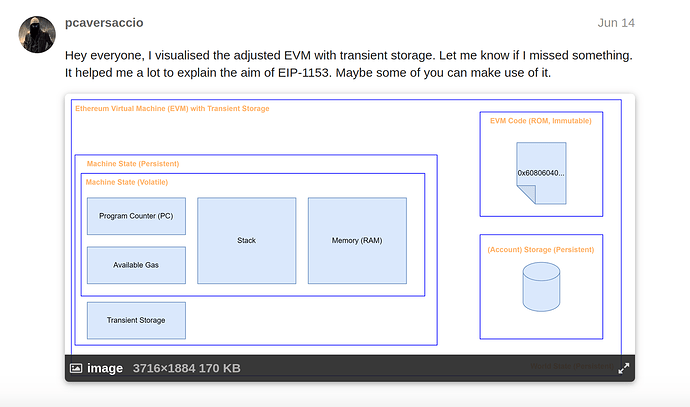As for storage pricing and refunds: the main point there is that you’re left with one cold load no matter what refunds and whatnot, right? Can a cold load from a full zero page in verkle trees be cheaper as well, hence allowing for reserving full pages as transient storage? Honestly, I have no idea, maybe not. Maybe even if, it’s messy and not a good idea to go that way. But that’s not my area of expertise. But the advantage of this direction is that the clearing is fully explicit and the EVM semantics stays simpler and there’s no implications for composability as Chris hinted at. (Of course at the cost of more complex gas accounting no matter what, but that complexity is actually less relevant for analysis and FV, since you can usually assume to have enough gas for that purpose anyways)
As for memory mappings: A full loop iteration for iterating a list I’d guess at 10-20 gas, so worst case you’re at 100 with 5 to 10 elements, average case 10 to 20 - that’s not a long way. (Granted that’s only comparing reading the thing, and writing to it before would be quite more costly in a transient storage version as well) But anyways, of course you don’t see memory maps around now, since they’re costly and a pain to implement right now - which may change with the ability of abusing transient storage for them, that’s the main point :-). And if you did that, clearing the map is actually the costly part (since then you need to keep and traverse a list of keys), so you’re not unlikely to not do that. (and I mean, implementing cheap memory mappings in actual memory has been requested from us, it’s just not feasible with current memory design, but it’s not too crazy of a concept in general)
Maybe that concern is ultimately unwarranted, but I’d maintain that it’s a valid concern in any case.
To avoid this issue alone, restricting the address space would help. I.e. if I just don’t have enough transient storage available (either by restricting the address range of transient storage explicitly or implicitly by it only being possible to mark a low count of storage slots as transient via EOF), I can’t abuse it in this way. On the other hand, one of the use cases I’ve read also appears to be passing complex data structures like mappings through calls, it’s probably impossible to keep that and prevent the abuse as call-local mappings at the same time (personally, I’d still argue that passing data around like that would be better done with more flexible calldata in principle, but anyways).
What marking slots in EOF indeed doesn’t account for either is the increase in semantic complexity, that stays the same and is a clear gaping con of transient storage in general. It may be valid to conclude that the pros outweigh this - I’m personally not convinced by that, but I can relate to the opposite position. The fact that this doesn’t even occur in the list of relative cons of the EIP and I don’t exactly see it conceded as a valid concern, made me worry if it is even properly weighed in at all, though. (Also not entirely sure if people doing FV would appreciate a position of basically “FV is too hard anyways, so it doesn’t matter if it gets even harder” ;-))

